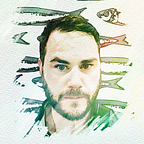Art and embracing new technology
I’m interested in the way people react to technologically-induced change. It seems to me that there’s a strong — perhaps overwhelming? — feeling in some quarters that new technology is generally awful and we were better off before. But I’m more interested in seeing the benefits as well as the drawbacks, in finding opportunity in transformation, and I like to see examples where radical change is welcomed.
All that’s a way of introducing Painting With Light, a fascinating new exhibition at Tate Britain that explores the effect of the invention of photography on art, especially the 19th Century Pre-Raphaelite society.
Brief aside: I’m not an art historian so much of the following is based on my notes from the exhibition plus brief online research and light prior knowledge. I take responsibility for any misinterpretation.
It’s fair to say that many painters were not pleased by the invention of the photograph (commonly dated to 1839). The French painter Paul Delaroche is often quoted as saying, on first seeing a daguerrotype (the early form of photograph): “from today, painting is dead”.
But some artists were less afraid of the new invention. The Scottish painter David Octavius Hill wanted to record a major change in the Church of Scotland in a picture which involved hundreds of people. He worked with the photographer Robert Adamson to get photographic portraits of all those present, and use them as a reference to paint the scene over a period of some 20 years. The finished work, known as The Disruption Picture, looks rather like a photographic collage; it has an air of Peter Blake’s work some 100 years later on the Beatles’ Sgt. Pepper album cover.
The English historical artist William Etty praised daguerrotypes for reviving the realism of great artists such as Rembrandt, Titian, and Spagnoletto. And the eminent art critic and artist (among many other roles), John Ruskin, agreed. Ruskin believed that truth was found in details, in clarity:
The greatest thing a human soul ever does in this world is to see something and tell what it saw in a plain way. To see clearly is poetry, prophecy and religion, all in one.
So Ruskin was very taken by the rapid capture and fidelity promised by photography, strongly defending it from critics in a letter:
Photography is a noble invention, say what they will of it. Anyone who has worked, blundered and stammered as I have done [for] four days, and then sees the thing he has been trying to do so long in vain, done perfectly and faultlessly in half a minute, won’t abuse it afterwards.
Ruskin’s theories heavily influenced the Pre-Raphaelite Brotherhood, a circle of painters, poets and critics, who disdained classicism and discovered meaning in details previously overlooked, ‘rejecting nothing, selecting nothing’. The Pre-Raphaelites were quick to see the advantages of photography, using extensive photographic reference in painting their super-detailed textures, light and portraits.
Over time the Pre-Raphaelite circle expanded and influenced many other artists, including photographers such as Julia Margaret Cameron. In his memoirs, the artist William Bell Scott wrote:
The seed of the flower of Pre-Raphaelitism was photography.
Photography has subsequently influenced art in many ways, but it’s interesting to see that, at its inception, those who might have felt that they were in competition — an artistic movement known for their devotion to the realism of detail — wholeheartedly embraced the new technology to improve their work. And in return, photographers were influenced by painting, using the years of experience of composition and arrangement to create great works of art.
There were a few other notes of interest that I gleaned from the exhibition. First, that some artists would take photos of their paintings so that they could more quickly experiment with modifications and variations; an early understanding of the utility of photocopying.
And Pre-Raphaelitism and photography also combined in an interesting way through Henry Wallis’ The Death of Chatterton.
This painting was phenomenally successful, drawing large crowds when exhibited. A certain James Robinson made a tableau vivant (a posed photographic reconstruction) of the painting and sold copies of it. The then-owner of the photograph, Augustus Egg, was forced to take Robinson to court, making it the first art copyright case.
Robinson’s photograph is shown in the Tate exhibition in the form of a stereograph. This method, invented in the 1850s shortly after photography, involves taking two identical images and displaying them side by side, then viewing them through prismatic lenses that create the illusion of depth. If that sounds familiar: yes, it’s how modern VR works!
Originally published at Peter Gasston.
